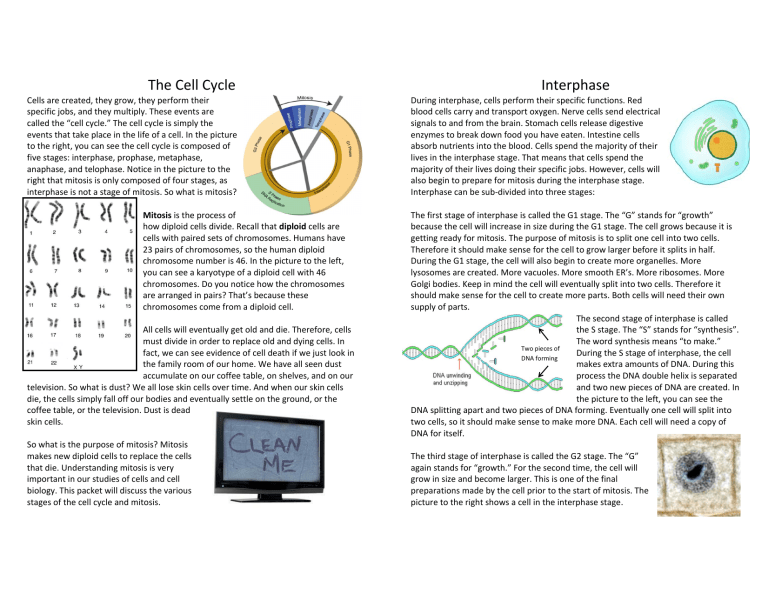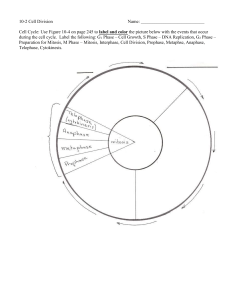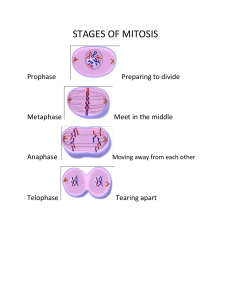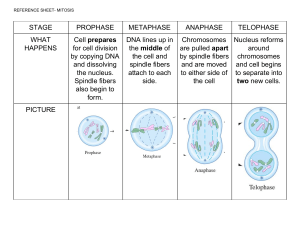
The Cell Cycle Cells are created, they grow, they perform their specific jobs, and they multiply. These events are called the “cell cycle.” The cell cycle is simply the events that take place in the life of a cell. In the picture to the right, you can see the cell cycle is composed of five stages: interphase, prophase, metaphase, anaphase, and telophase. Notice in the picture to the right that mitosis is only composed of four stages, as interphase is not a stage of mitosis. So what is mitosis? Mitosis is the process of how diploid cells divide. Recall that diploid cells are cells with paired sets of chromosomes. Humans have 23 pairs of chromosomes, so the human diploid chromosome number is 46. In the picture to the left, you can see a karyotype of a diploid cell with 46 chromosomes. Do you notice how the chromosomes are arranged in pairs? That’s because these chromosomes come from a diploid cell. All cells will eventually get old and die. Therefore, cells must divide in order to replace old and dying cells. In fact, we can see evidence of cell death if we just look in the family room of our home. We have all seen dust accumulate on our coffee table, on shelves, and on our television. So what is dust? We all lose skin cells over time. And when our skin cells die, the cells simply fall off our bodies and eventually settle on the ground, or the coffee table, or the television. Dust is dead skin cells. So what is the purpose of mitosis? Mitosis makes new diploid cells to replace the cells that die. Understanding mitosis is very important in our studies of cells and cell biology. This packet will discuss the various stages of the cell cycle and mitosis. Interphase During interphase, cells perform their specific functions. Red blood cells carry and transport oxygen. Nerve cells send electrical signals to and from the brain. Stomach cells release digestive enzymes to break down food you have eaten. Intestine cells absorb nutrients into the blood. Cells spend the majority of their lives in the interphase stage. That means that cells spend the majority of their lives doing their specific jobs. However, cells will also begin to prepare for mitosis during the interphase stage. Interphase can be sub-divided into three stages: The first stage of interphase is called the G1 stage. The “G” stands for “growth” because the cell will increase in size during the G1 stage. The cell grows because it is getting ready for mitosis. The purpose of mitosis is to split one cell into two cells. Therefore it should make sense for the cell to grow larger before it splits in half. During the G1 stage, the cell will also begin to create more organelles. More lysosomes are created. More vacuoles. More smooth ER’s. More ribosomes. More Golgi bodies. Keep in mind the cell will eventually split into two cells. Therefore it should make sense for the cell to create more parts. Both cells will need their own supply of parts. The second stage of interphase is called the S stage. The “S” stands for “synthesis”. The word synthesis means “to make.” Two pieces of During the S stage of interphase, the cell DNA forming makes extra amounts of DNA. During this process the DNA double helix is separated and two new pieces of DNA are created. In the picture to the left, you can see the DNA splitting apart and two pieces of DNA forming. Eventually one cell will split into two cells, so it should make sense to make more DNA. Each cell will need a copy of DNA for itself. The third stage of interphase is called the G2 stage. The “G” again stands for “growth.” For the second time, the cell will grow in size and become larger. This is one of the final preparations made by the cell prior to the start of mitosis. The picture to the right shows a cell in the interphase stage. Prophase Metaphase Now that the cell has prepped for mitosis, mitosis can begin. Remember that the point of mitosis is to split one cell into two cells. The first stage of mitosis is called prophase. Several key events take place during prophase. In the previous stage of the cell cycle called prophase, spindle fibers were created. Spindle fibers are long, thin threads of protein that grow from organelles called centrioles. In the picture below, you can see a diagram of a cell with the centrioles highlighted. During metaphase, those spindle fibers will attach themselves to the centromere location on every chromosome. If you recall, humans have 46 chromosomes in every cell. So the spindle fibers will attach themselves to the centromere location on all 46 chromosomes. In the picture below you can see a diagram of a chromosome. If you recall, the centromere is the location where the two halves of a chromosome overlap one another. The two halves of a chromosome are called “chromatids.” At the start of prophase, the cell’s DNA is in a long, loose form called chromatin. An analogy would be a long strand of spaghetti. During prophase, the loose chromatin begins to coil and tighten into easily movable structures called chromosomes. In the picture to the right, you can see the X shaped chromosome is made from a long, loose strand of DNA called chromatin. So what is the point of condensing the DNA into chromosomes? During mitosis, the cell must move its DNA from one cell to another. As an analogy, while packing clothing for a vacation, it makes sense to condense all your clothing into one easily moveable suitcase. When cells divide, they will package their DNA into easily movable packages called chromosomes. During prophase, human DNA condenses into 46 moveable chromosomes. The purpose of the nucleus is to store and protect DNA. But during prophase, the nucleus is simply in the way. During prophase, the nucleus of the cell will dissolve. There are enzymes within the cytoplasm that actively break apart the nucleus. In the picture to the right you can see the nucleus of the cell is breaking apart. Nucleus breaking apart centrioles centrioles Spindle fibers Spindle fibers Another key step of prophase is the formation of spindle fibers. Spindle fibers are created by organelles called centrioles. As we progress through the stages of mitosis, we will learn the function of spindle fibers. In the picture to the left, you can see the centrioles at opposite ends of the cell and spindle fibers growing from the centrioles. The picture to the right shows a cell in the prophase stage of mitosis. Once the spindle fibers attach to the chromosomes, the spindle fibers engage in a “tug-of-war” contest. During metaphase, the spindle fibers pull and tug on the chromosomes until all chromosomes are aligned in the middle of the cell, called the equator. In the drawing below, you can see the X shaped chromosomes are aligned in the middle, or equator, of the cell. This is a drawing of a cell in the metaphase stage. Chromosomes aligned in the middle of the cell Chromosomes aligned in the middle of the cell Anaphase Telophase In the previous stage, Metaphase, the chromosomes were pulled to the center (equator) of the cell by the spindle fibers. In human cells, there will be 46 chromosomes aligned along the cell’s equator. In the picture below, the cell appears to be in the metaphase stage. Before we proceed, let’s remember, chromosomes are tightly coiled pieces of DNA. In the diagram to the right, you can see that every chromosome is made from two halves called chromatids. Now that the chromosomes are aligned at the cell’s equator, the spindle fibers are going to continue their tug-of-war battle. During anaphase, the spindle fibers are going to pull at the chromosomes in opposite directions. In the picture to the left, you can see this cell has 4 chromosomes aligned in the cell’s equator. But in the picture to the right, you can see the 4 chromosomes are being ripped apart as the spindle fibers continue their tug-of-war contest. In the picture to the right, you can see 4 chromatids being pulled to the left of the cell and 4 chromatids pulled to the right of the cell. In human cells, 46 chromosomes are aligned in the middle of cells during metaphase. Therefore during anaphase in human cells, 46 chromatids would be pulled to the left of the cell, while 46 chromatids would be pulled to the right of the cell. Anaphase is an easy stage to recognize under the microscope. In the picture to the right, you can see a cell in the process of anaphase. In the picture to the right, you can see half the chromatids being pulled to the left and the other half being pulled to the right. Chromatids separating In the previous stage of mitosis called anaphase, the chromosomes of a cell are ripped apart. Half the chromatids are pulled to the left and the other half are pulled to the right. The picture to the right shows anaphase. Now that anaphase is complete, the cell will enter the final stage of mitosis called telophase. Remember the purpose of mitosis is to split one cell into two cells. Therefore, by the end of telophase, two complete cells should exist. There are many events that happen during telophase. One key moment of telophase is the return of the nucleus. The nucleus’ job is to protect the DNA. Now that mitosis is nearly finished, the nucleus will reform in order to protect the DNA of the Nuclei reforming two cells. In the picture to the left, you can see two nuclei forming. Eventually, the cell will split in half and each cell will contain one nucleus. Another major event that happens during telophase is the division of the cytoplasm. This process is called cytokinesis. In the picture to the right, you can see the cell is pinching inward. Cytokinesis helps to physically break apart the left cell from the right cell. One of the final events of telophase is the return of DNA back into the loose strands called chromatin. If you recall during anaphase, 46 chromatids were pulled to the left of the cell. Those 46 chromatids will unwind into 46 loose strands of chromatin. If you recall, 46 chromatids were pulled to the right of the cell. Those 46 chromatids will unwind into 46 loose strands of chromatin. In the picture to the left, you can see that a chromatid is unwinding into a long, loose strand of chromatin. In the picture to the right, you can see a cell in the telophase stage. Notice how the cell is virtually split into two complete cells. This is the final stage of the cell cycle. Why should we care about Mitosis? The #2 cause of human death on Earth is cancer. Cancer is a disease where cells are constantly dividing by the process of mitosis. Normally, when a cell goes through mitosis to make new cells the process will end with telophase. But in cancer cells there are errors that prevent the shutoff of mitosis. Cancer cells are basically stuck in mitosis. Therefore our understanding of mitosis is important in the battle to save millions of lives per year. Chances are that you personally know someone who has battled cancer in their lives. If a person has cancer, the cancer cells are constantly dividing by mitosis. As the cancer cells multiply and multiply and multiply, eventually a lump of cancer cells begins to form. This lump of cancer cells is called a tumor. Tumors can be hazardous for a variety of reasons. One reason tumors can be hazardous is because often cancer cells can metastasize. This simply means that a few cancer cells can break away from the tumor and travel in your blood stream to another part of your body. The spreading of cancer cells from one area to another can spread the cancer cells around the body. This makes treatment very difficult. Treating cancer can be very difficult because cells are microscopic. The average human body is made from approximately 100 trillion cells. There is no easy way to find and kill all the cancer cells. When cancer cells are found, they can be targeted with X-ray radiation as a way to kill them. However, radiation also kills normal cells as well as cancer cells. If you have ever had a relative undergo radiation treatment, you may know this causes the person to get very sick. This is because the radiation treatment is killing the person’s healthy cells as well as the cancer cells. In the picture to the left, you can see radiation is being applied to a specific area of a person who has cancer. The X-ray radiation will hopefully kill the cancer cells and shrink the tumor. As our knowledge of cells and mitosis grows, this may lead to new treatments in the battle of cancer. Knowledge of mitosis may one day save your life.







